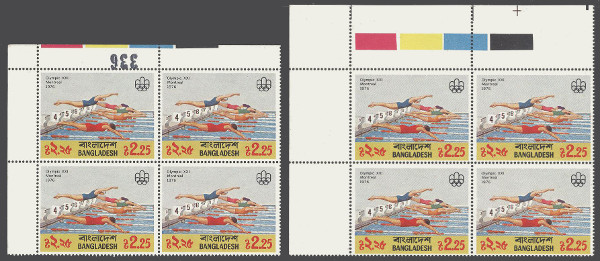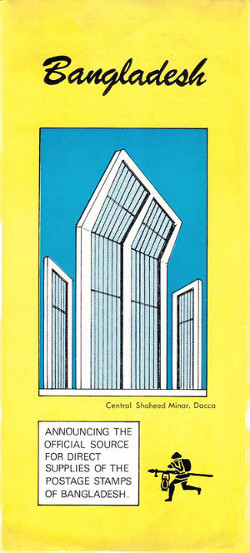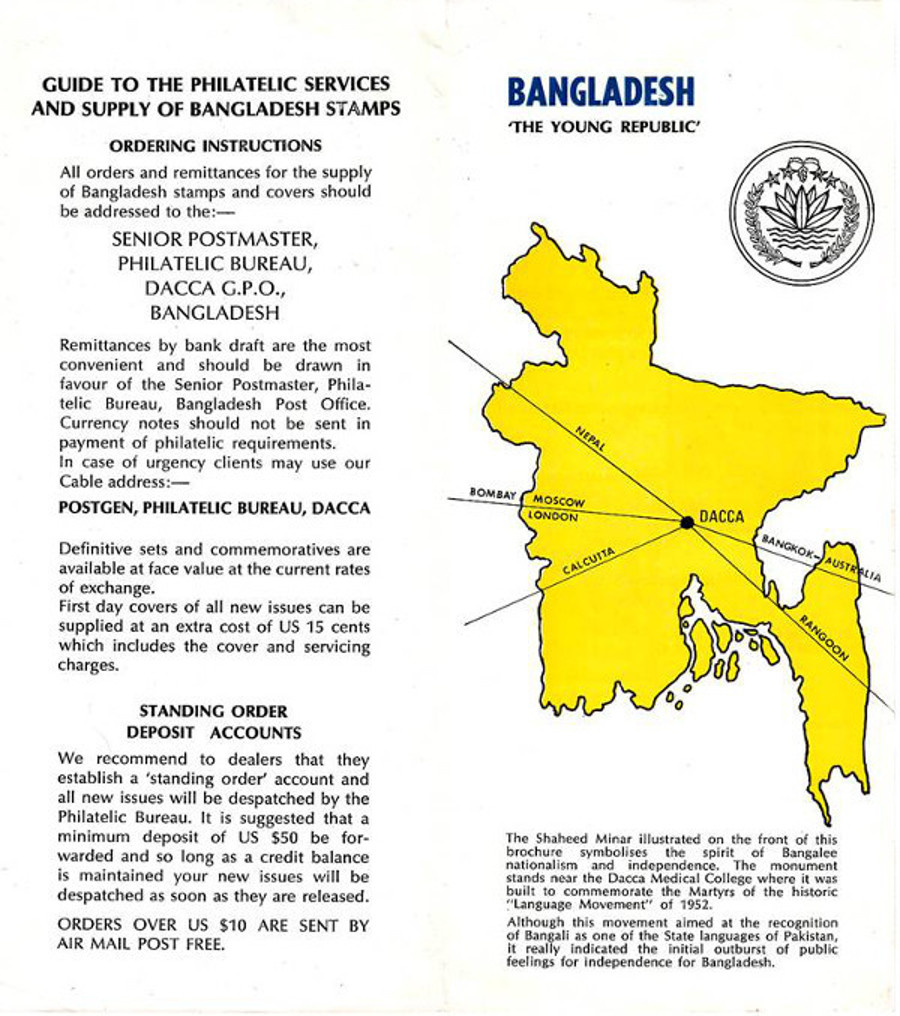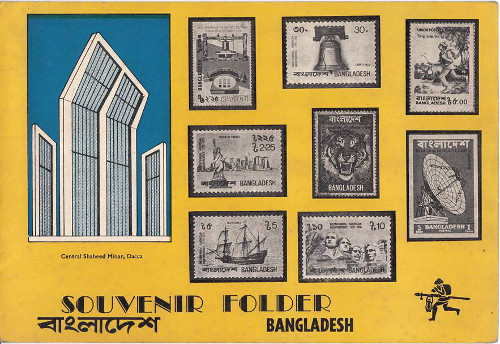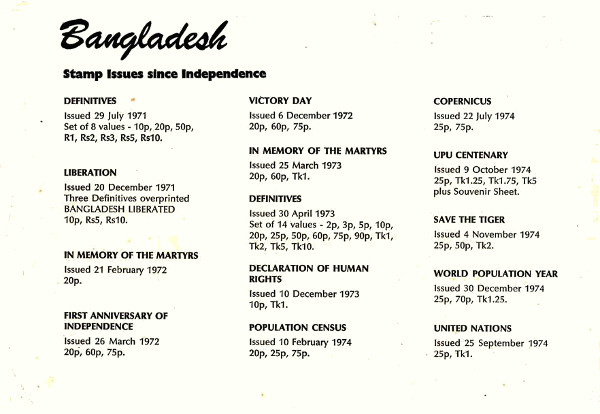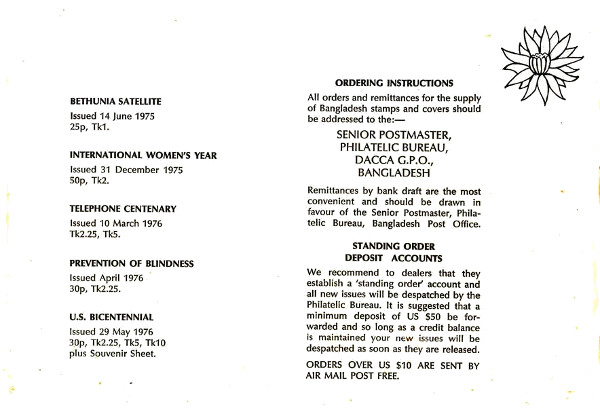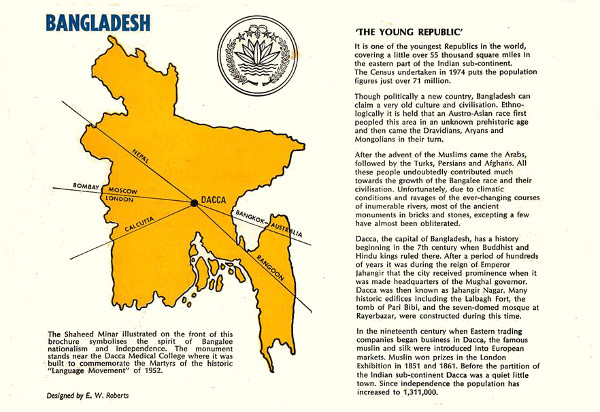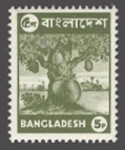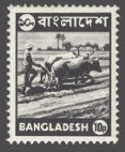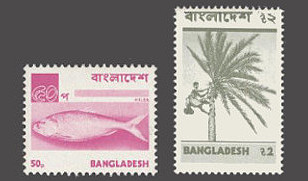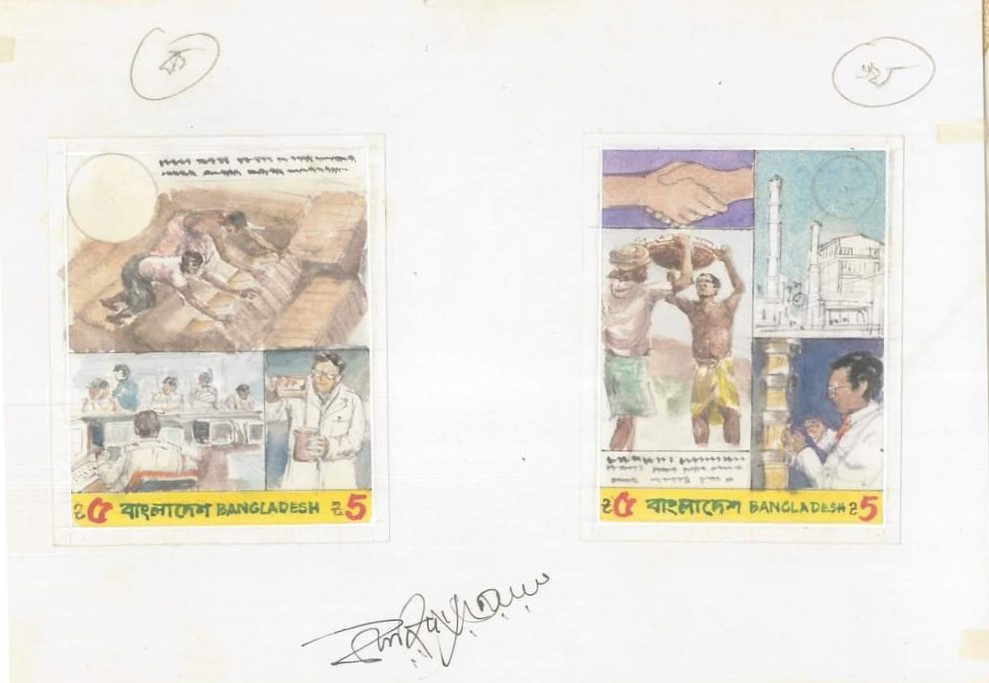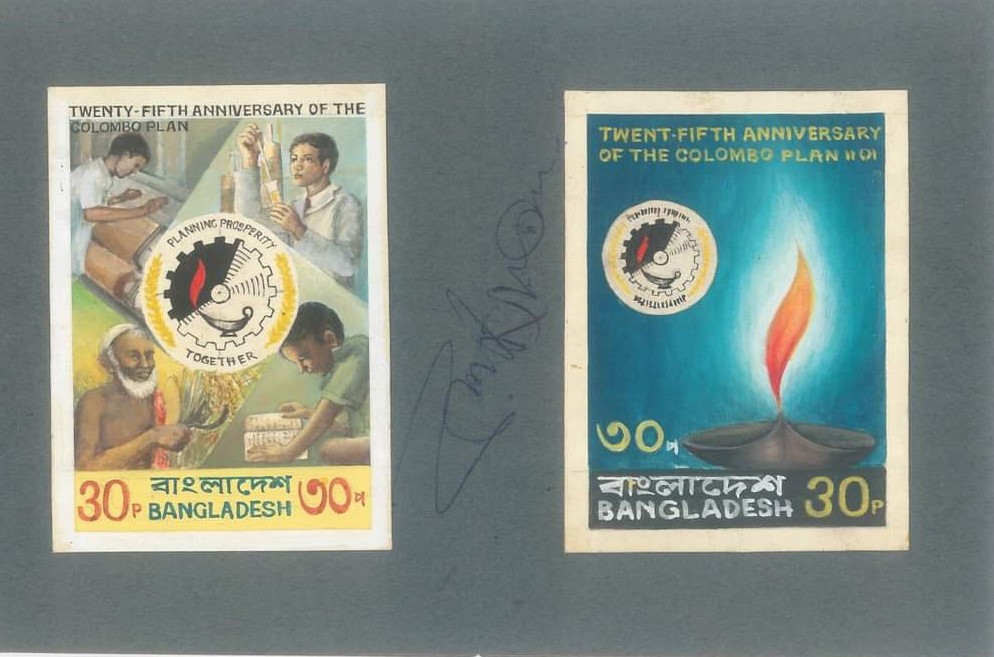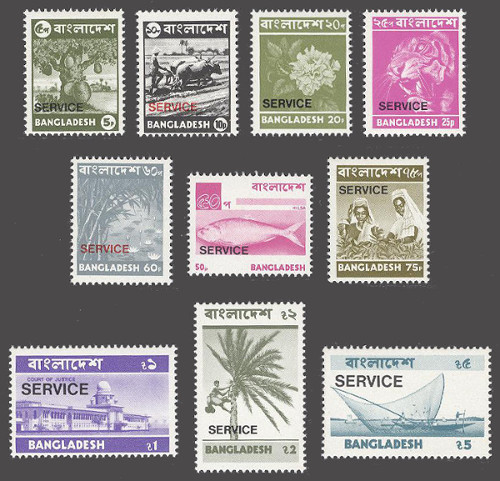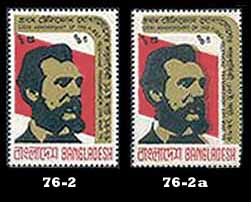
The stamp on the right shows a shift in athe gold color, leaving a space between the image and the right side. While this is minor it is very collectible due to the small quantities of stamps printed for most commemorative issue.
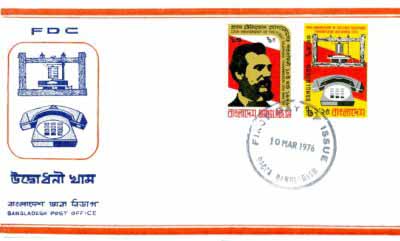
76-1 Tk.2.25 Old and new telephones – multicolored
76-2 Tk.5 Alexander Graham Bell – multicolored
a. gold shifted slightly to the right
2 stamps
CCMs:
Plate #:
Sheet: 50
Quantity printed: 125,000 of each value
Designer: Art & Beauty, Dhaka
Printer: Asher & Co., Melbourne, Australia
FDC: Yes. Generic postmark FIRST DAY OF ISSUE/date/DACCA BANGLADESH
Pmks.: Dacca, Jessore
Insert: Light gray card stock, printed in black.
Additional: Imperforate progressive proofs exist
Tk.2.25
1. Gray telephone image
2. Tan background
3.Gray outlines of telephones
4. Printed on #2 above
5. Red alone
6. All above combined in completed image
Tk.5
1. Gold background
2. Red added to the above
3. Black added to #2 above for completed stamp
The image of the black text has not been seen but must exist
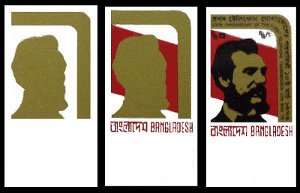
This set of progressive proofs did not surface until mid-December 2014 and were in a “senior” collectors collection. More than one set is known. Note that two of the proofs that should exist for one of the stamps is not shown – the bottom stamp. Missing are the single proofs of the black and the red. There is speculation that the owner is holding onto them to increase the price when other sets are offered.
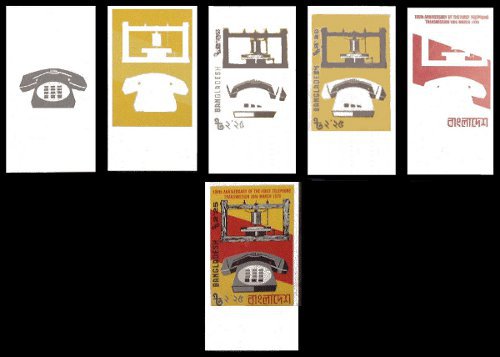
Presentation Booklet
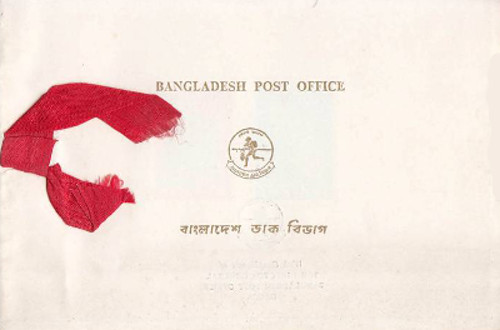
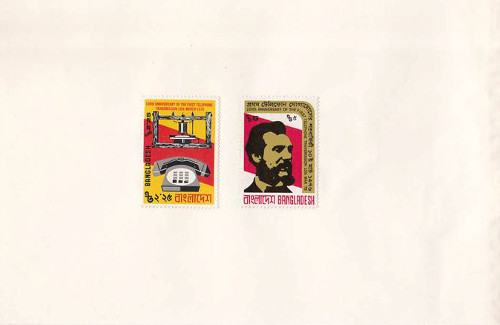
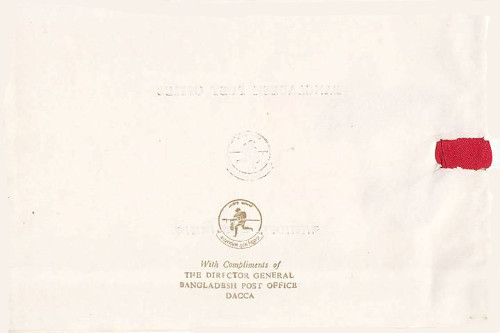
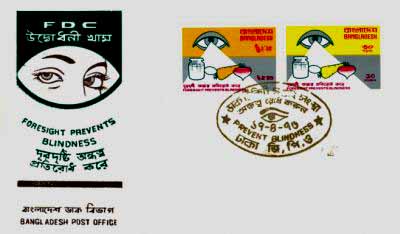
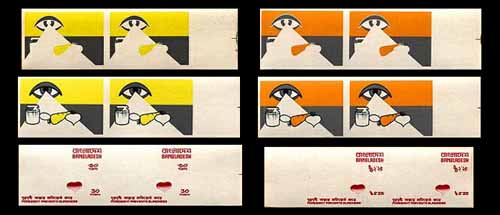
Imperforate progressive proofs for the 1976 World Health Day issue.
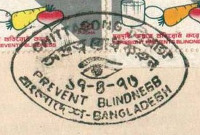
76-3 30p
a. imperforate
76-4 Tk.2.2
a. imperforate
2 stamps
CCMs:
Plate #:
Sheet: 50
Quantity printed: 125,000 of each value
Designer: Ahmed Fazlul Karim
Printer: Asher & Co. Melbourne, Australia
FDC: Yes. Commemorative postmark.
Pmks.: Chittagong, Dacca
Insert: White card stock, printed in black.
Additional: For some reason this stamp is often described as a Revenue Stamp in internet auctions by foreign dealers, but it is a postage stamp.
Imperforate progressive proofs exist:
1.Yellow and black
2 Red denomination
3. Orange and black
4 Red denomination.
Presentation Booklet

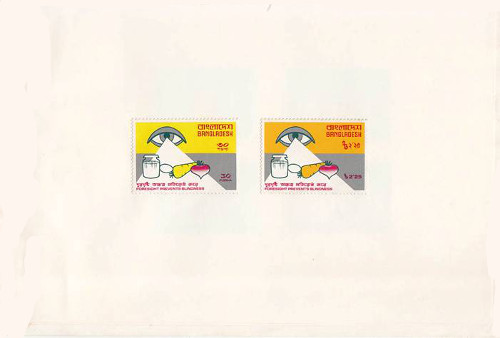


76-5 30p Liberty Bell – multicolored
76-6 Tk. 2.25 Statue of Liberty – multicolored
76-7 Tk.5 Mayflower – multicolored
76-8 Tk.10 Mt. Rushmore (President=s heads) – multicolored
76-9ss Tk.20 SS – perf. Sheet contains the four stamps
76-9ssi Tk.20 SS – imperf. Sheet contains the four stamps
4 stamps and 1 SS
CCMs:
Plate #:
Imperforate: No. Imperforate singles that one occasionally sees are from the imperforate souvenir sheet.
Sheet: 50
Quantity of stamps printed: 1,000,000 of each value, or the total of the four (?).
Quantity of perf. SS printed: unknown
Quantity of imperf. SS printed: It is believed that 500 sheets made it to the philatelic market. They were not officially issued by the Post Office.
Designer of stamps and SS: E.W. Roberts (Australia)
Printer: Heraclio Fournier, Spain
FDC: Yes. Commemorative postmarks – three different. FDCs most likely exist for the individual stamps, but only the Statue of Liberty (that matches the cachet design) is the most common, the four on one cover, the SS sheet (and stamps ?) cancelled on the special envelope from the U.S. stamps show and the SSs, both perforated and imperforate on the large sized envelope with the Spanish provided cancelling device.
Pmks.: Dacca, Philadelphia/Interphil – Stamps and souvenir sheet, Rajshahi, Liberty Bell postmark – scarce.
Insert: Light gray card stock, printed in black (For stamps only).
Additional: The souvenir sheet was not available for making FDCs in Bangladesh. Although the imperforate SS was not oficially issued, it appeared on the market and is not difficult to find. It is often said to be “rare”, but that is not really the case. It is definitely more expensive than the issued perforated sheet. The original artwork for the individual stamps exist.
ALSO SEE: Special Postmarks for 1976. A special cancellation was created for a stamp expo at the American Cultural Center, Dhaka, on 11 June 1976 commemorating the American Bicentennial. It is a very rare cancellation that many collectors know nothing about and have never seen
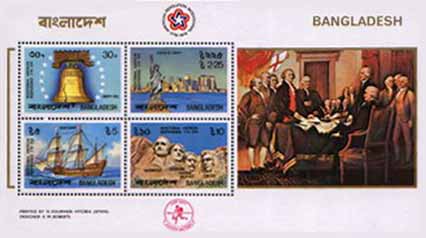
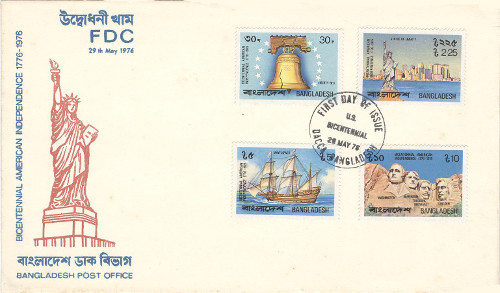
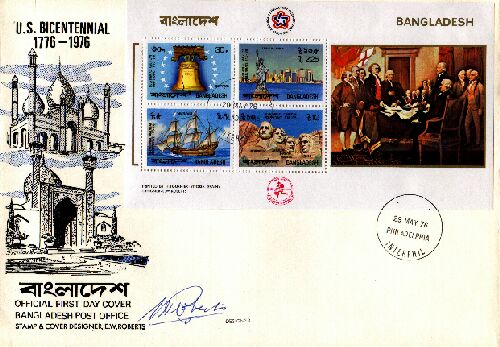
A First Day Cover of the U.S. Bicentennial souvenir sheet, cancelled on the date of issue, but in Philadelphia, USA at the INTERPHIL stamp show. This cover is signed by the individual who designed the stamps, souvenir sheet and this cover, E.W.Roberts, who is an Australian. This cover does not have the Post Office logo printed on the reverse flap and is privately printed. I have been told that there are FDCs with the four stamps on them on this envelope.
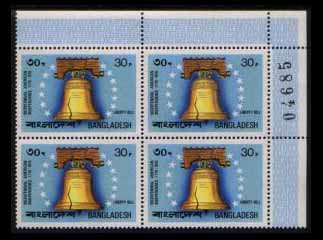
This block of four is from a sheet of the Liberty Bells stamps, showing the margin around the sheet. Do not confuse the numbers in the right margin with a Plate Number. A Plate Number is engraved in the plate and is the same on all sheets until a new plate is used to print the same stamp design. These numbers are most likely used in counting the sheets and every sheet should have a different number.
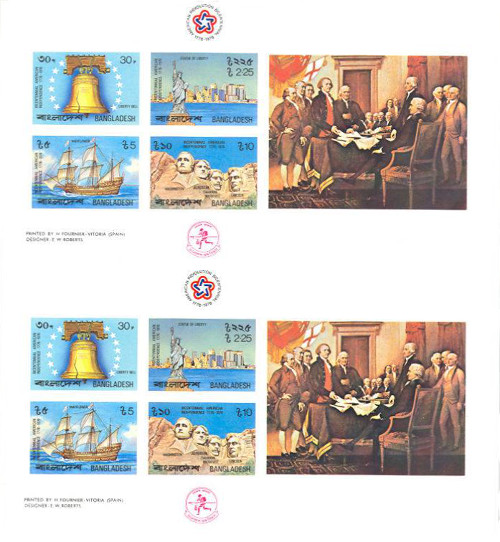
An uncut sheet of two imperforate Souvenir Sheets.
Three Different Envelopes
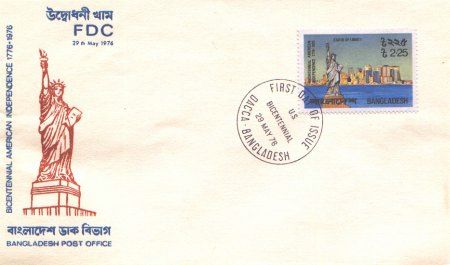
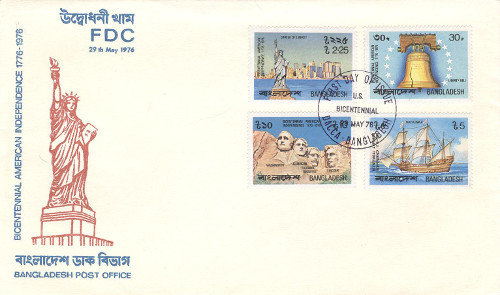
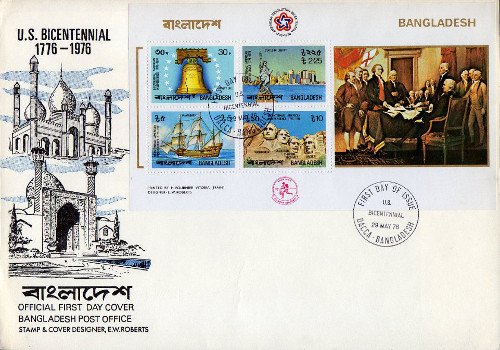
Three Different Cancellations:
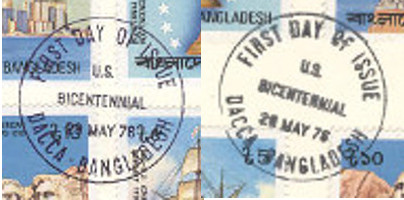
Differences in cancellations due to the quality of ink used Inks:
1. A small quantity of high-quality ink is provided along with the cancellation device by the printer of the stamps.
2. Another black ink was later used with the cancelling device sent by the printer.
3. A cheaper quality oily ink used largely with the Liberty Bell cancelling device

For some reason, the two cities of Chittagong and Rajshahi had a similar cancellation that was very different from that used in the capital, Dacca. It was an attractive “Liberty Bell” and was only used in those two cities. The covers are quite expensive and not easily found. This is an example from Chittagong. This is the larger of the two envelopes prepared by the Bangladesh Post Office. It was to be used for the souvenir sheet, but I have only seen the set of single stamps on this size of cover. The souvenir sheet is really too large to fit nicely on this envelope. To do so, much of the design on the left would be covered.
1. Commemorative Liberty Bell, designed by P.O. The cancellation was used in Rajshahi and Chittagong,
with the city name in the cancellation. Largely used for covers prepared by collectors in Bangladesh. These covers are not easy to find.
2. A circular cancellation provided by the Spanish printers of the stamps and SSs that
reads “The FIRST DAY OF ISSUE/U.S. BICENTENNIAL/29 MAY 1976/DACCA BANGLADESH”. This was generally used on all foreign orders of the covers.
3. A circular one similar to the one provided by the printer but used for the stamps and souvenir sheet was cancelled at the Philadelphia, PA, USA INTERPHIL stamp show. The postmark reads 29 MAY 76/PHILADELPHIA/INTERPHIL.
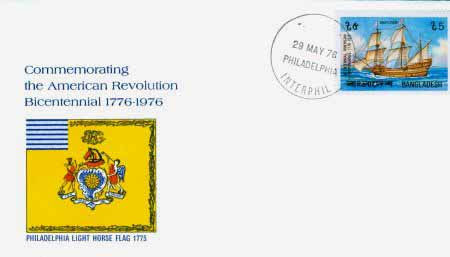
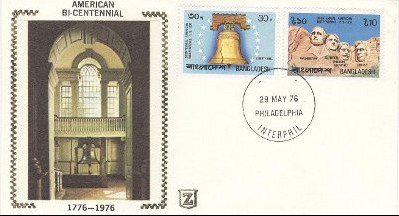
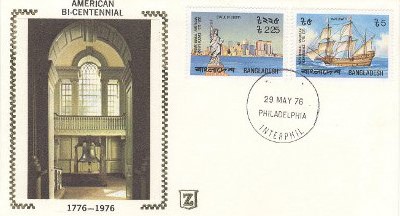
TOP: One of the stamps from the set of four, but cancelled on an envelope with a different cachet, and the INTERPHIL postmark. Covers with the individual, or set, of stamps for this issue are seldom seen on covers bearing the INTERPHIL postmark.
BOTTOM: Two covers with the INTERPHIL postmark. Because INTERPHIL was held in the United States, during the Bicentennial Year, many American generic cachets were produced and dealers and collectors used them to make covers with the stamps of many countries.
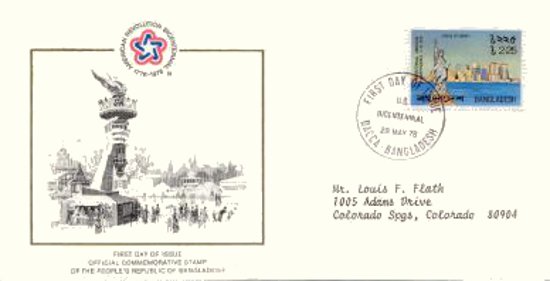
A cover created by a company selling the new issues commemorating the U.S. Bicentennial. Most people who subscribed to the subscription service were not regular stamp collectors and seldom realized that most of the covers only contained one stamp of a set. Also, they did not realize that modern FDCs are collected unaddressed. The companies advertise them as being “personalized, with your name on them”. It is a common practice for companies to create a subscription series for a specific event, and as stated, they are generally subscribed to by non-stamp collectors. A few years after the event many collectors lose interest in the collection and they become a glut on the market and are sold at low prices. This cover is very common and is frequently seen in internet auctions.
I. One of the stamps from the set of four, but cancelled on an envelope with a different cachet, and the INTERPHIL postmark. Covers with the individual, or set, of stamps for this issue are seldom seen on covers bearing the INTERPHIL postmark.
II. Two covers with the INTERPHIL postmark. Because INTERPHIL was held in the United States, during the Bicentennial Year, many American generic cachets were produced and dealers and collectors used them to make covers with the stamps of many countries.
Presentation booklet

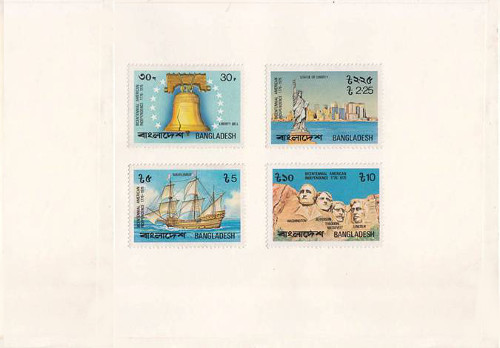

Original art work
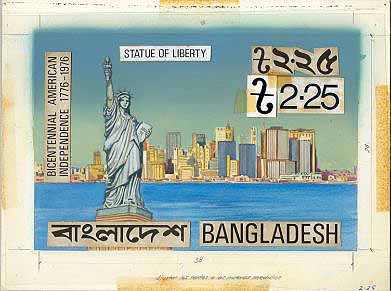
The Proofs
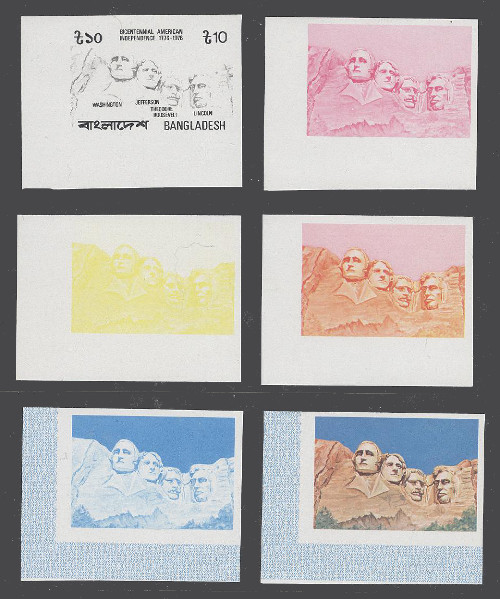
Proofs similar to the above exist for all four of the stamps.
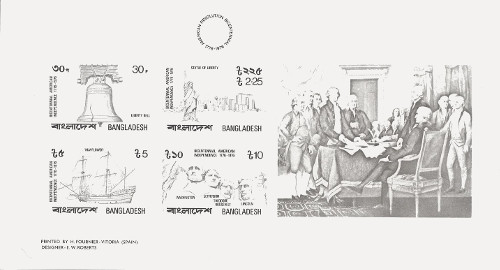
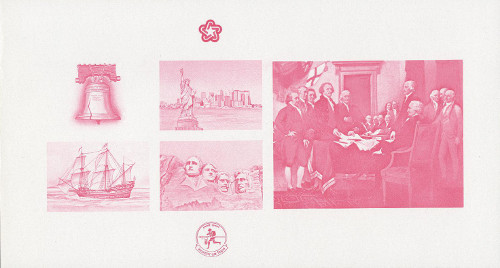
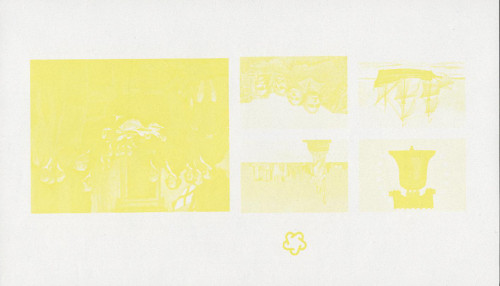
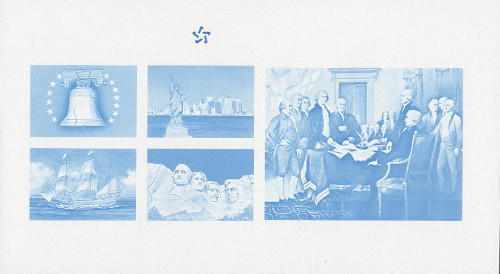
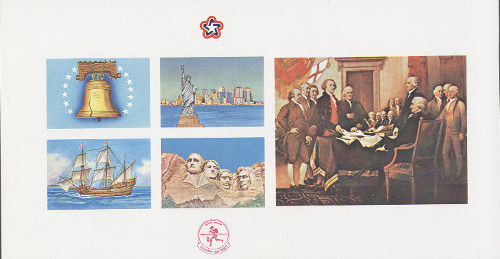
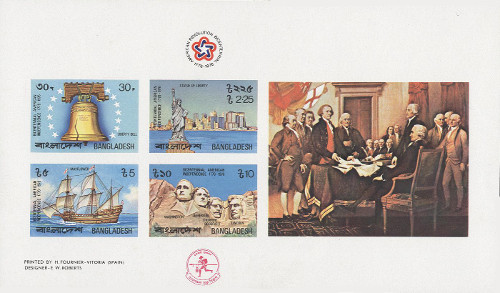
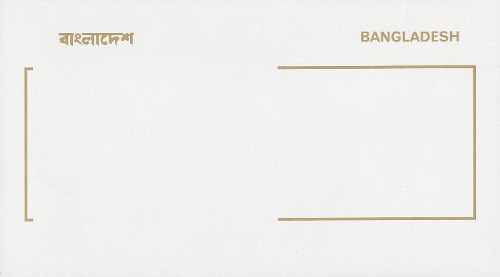
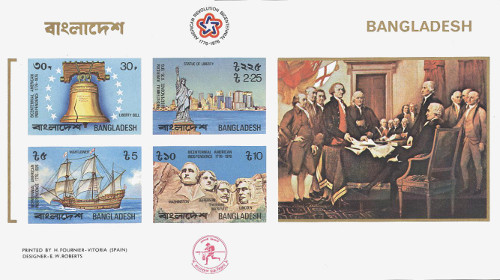
Printer's waste
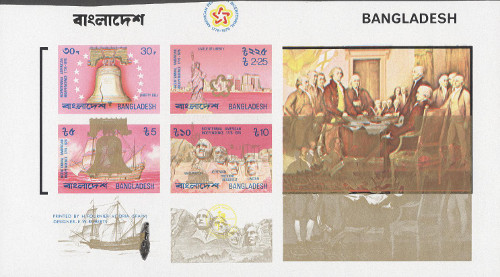
Printer’s waste, with not all the colors printed, the black shifted downward, the gold color is printed black, and an ink blob on the bottom left on the ship.
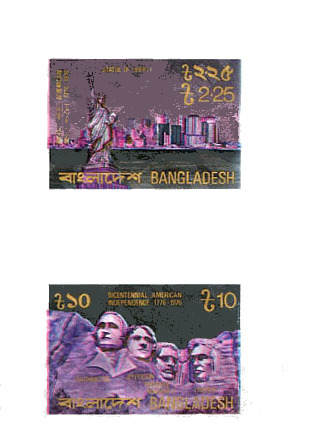
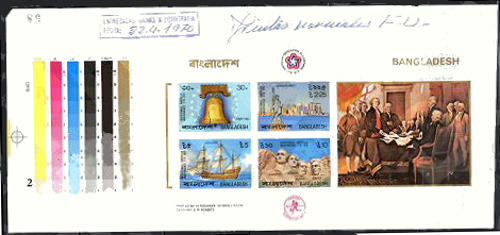
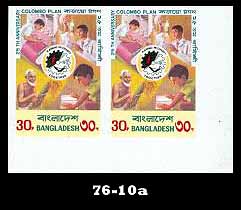
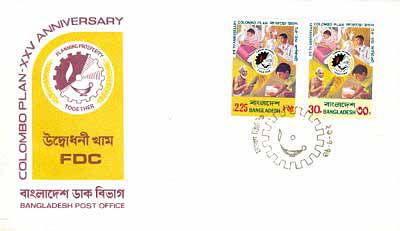
76-10 30p Various occupations and emblem in the center – multicolored
a. imperforate
76-11 Tk.2.25 Various occupations and emblem in the center – multicolored
a. imperforate
2 stamp
CCMs: Yes
Plate #: None
Sheet: 50
Quantity printed: 125,000 of each value (A quantity of the Tk.2.25 value was overprinted for the 27 December, 1984 KHULNAPEX-84 issue)
Designer: K.G. Mustafa
Printer: Asher & Co. Melbourne, Australia
FDC: Yes. Commemorative postmark.
Parks.: Chittagong, Dacca, Rajshahi
Insert: White card stock printed in black.
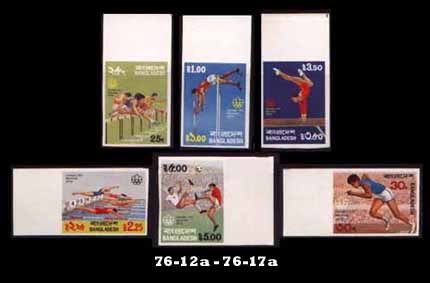
I have been told that this 29 November, 1976 imperforate Montreal Olympic set is not easy to find. It is believed that single imperforate stamp with the margin were probably sold by Indian dealers as the Bangladesh dealers sell them in blocks of four or pairs.
76-12 25p Jumping hurdles – multicolored
a. imperforate
b. on green paper
76-13 30p Running – multicolored
a. imperforate
b. on green paper
76-14 Tk.1 High jump – multicolored
a. imperforate
b. on green paper
76-15 Tk.2.25 Swimming – multicolored
a. imperforate
b. on green paper
76-16 Tk.3.50 Gymnastics – multicolored
a. imperforate
b. on green paper
76-17 Tk.5 Soccer – multicolored
a. imperforate
b. on green paper
6 stamps
CCMs: There is a color control mark on the sheets but they were trimmed so that only a small portion of the colors show. Examples have only been seen to date on the Tk.2.25 (#76-15) value where there is an extra wide margin and the entire color guide is visible.
Plate #:
Sheet: 50
Quantity printed: 300.000 of each value
Designer: K.G. Mustafa (Art & Beauty, Dhaka)
Printer: Asher & Co. Melbourne, Australia
FDC:
Pmks.:
Insert:
